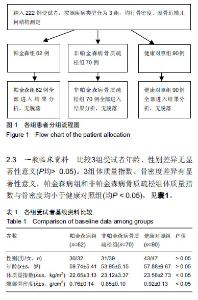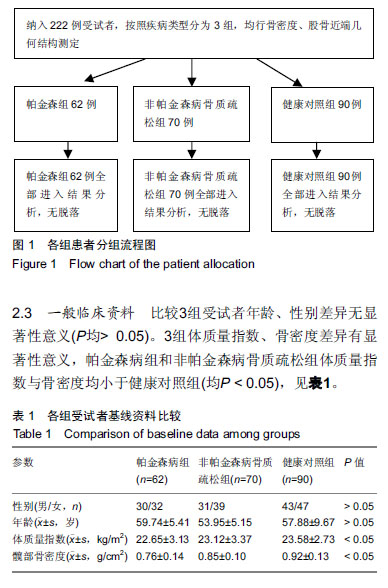| [1]Lyell V,Henderson E,Devine M, et al. Assessment and management of fracture risk in patients with Parkinson's disease. Age Ageing. 2015;44(1):34-41.[2]Mayor S. Parkinson's disease diagnosis is preceded by increased risk of falls, study finds. BMJ. 2016;352:i695.[3]Shribman S, Torsney KM, Noyce AJ, et al. A service development study of the assessment and management of fracture risk in Parkinson's disease. J Neurol.2014;261-266: 1153-1159.[4]Bhattacharya RK, Dubinsky RM, Lai SM, et al. Is there an increased risk of hip fracture in Parkinson’s disease? A nationwide inpatient sample. Mov Disord Off J Mov Disord Soc. 2012;27:1440-1443.[5]Critchley RJ, Khan SK, Yarnall AJ, et al.Occurrence, management and outcomes of hip fractures in patients with Parkinson's disease.Br Med Bull. 2015;115(1):135-142.[6]Pouwels S, Bazelier MT, Boer A, et al. Risk of fracture inpatients with Parkinson’s disease. Osteoporos Int 2013; 24:2283-2290.[7]刘文和,刘忠厚,陈鹏,等.老年人骨质疏松性髋部骨折与Singh指数和股骨近端几何结构的相关性初探[J].中国骨质疏松杂志, 2012,18(3):193-196.[8]Postuma RB, Berg D, Stern M, et al. MDS clinical diagnosis criteria for Parkinson's disease. Mov Disord. 2015;30(12): 1591-1601.[9]张智海,刘忠厚,李娜,等. 中国人骨质疏松症诊断标准专家共识(第三稿•2014版)[J]. 中国骨质疏松杂志,2014,20(9): 1007-1010.[10]中华医学会骨质疏松和骨矿盐疾病分会. 原发性骨质疏松症诊治指南[J]. 中华骨质疏松和骨矿盐疾病杂志, 2011, 4(1): 2-17.[11]张志敏,盛志峰,廖二元. FRAX软件在骨折风险预测中的研究进展[J]. 中华内分泌代谢杂志, 2012,28(12):1029-1032.[12]Chen YY, Cheng PY, Wu SL, et al. Parkinson’s disease and risk of hip fracture: an8-year follow-up study in Taiwan. Parkinsonism Relat Disord. 2012;18:506-509.[13]Tan L, Wang Y, Zhou L, et al. Parkinson’s disease and risk of fracture: a meta-analysis of prospective cohort studies. PLoS One. 2014;9:e94379.[14]Malochet-Guinamand S, Durif F,Thomas T. Parkinson's disease: A risk factor for osteoporosis. Joint Bone Spine. 2015; 82(6):406-410.[15]Torsney KM, Noyce AJ, Doherty KM, et al. Bone health in Parkinson's disease: a systematic review and meta-analysis. J Neurol Neurosurg Psychiatry. 2014;85-10:1159-1166.[16]戴鹤玲,孙天胜,刘智. 髋部骨密度和几何结构与老年髋部骨折发病的关系[J].中国老年学杂志,2013,33(2):294-296. [17]胡世弟,李瑾,刘璐,等.绝经后2型糖尿病患者髋部骨几何结构参数及影响因素[J].中华骨质疏松和骨矿盐疾病杂志, 2015,8(1): 13-20.[18]Zhang H,Hu YQ,Zhang ZL. Age trends for hip geometry in Chinese men and women and the association with femoral neck fracture. Osteoporos Int. 2011;22: 2513-2522.[19]Alonso CG,Curiel MD,Carranza FH,et al.Femoral bone mineral density,neck shaft angle and mean femoral neck width as predictors of hip fracture in men and women. Osteoporos Int. 2000;11:714-720.[20]张扬,雷伟,吴子祥.老年股骨上段标本几何参数及骨密度与生物力学性能的相关性分析[J].中国骨质疏松杂志, 2009,15(1): 32-35.[21]任晓静,蔡思清,吕国荣,等.髋部结构分析在预测髋部脆性骨折的意义[J].中国医学物理学杂志,2017,34(5):513-520. [22]Lacroix AZ,Beck TJ,Cauley JA,et al.Hip structural geometry and incidence of hip fracture in postmenopausal women: what does it add to conventional bone mineral density? Osteoporos Int. 2010;21: 919-929. [23]Gnudi S,Ripamonti C,Lisi L,et al. Proximal femur geometry to detect and distinguish femoral neck fractures from trochanteric fractures in postmenopausal women. Osteoporos Int. 2002;13(1):69.[24]黄际远,宋文忠,史克俭,等.成都地区健康人群髋部骨密度及几何参数变化的初步研究[J].中国骨质疏松杂志,2012,18(9): 798-802.[25]Dawson-Huqhes B, Tosteson AN, Melton LJ 3rd, et al. Implications of absolute fracture risk assessment for osteoporosis practice guidelines in the USA. Osteoporos Int. 2008;19(4):449-458. |





